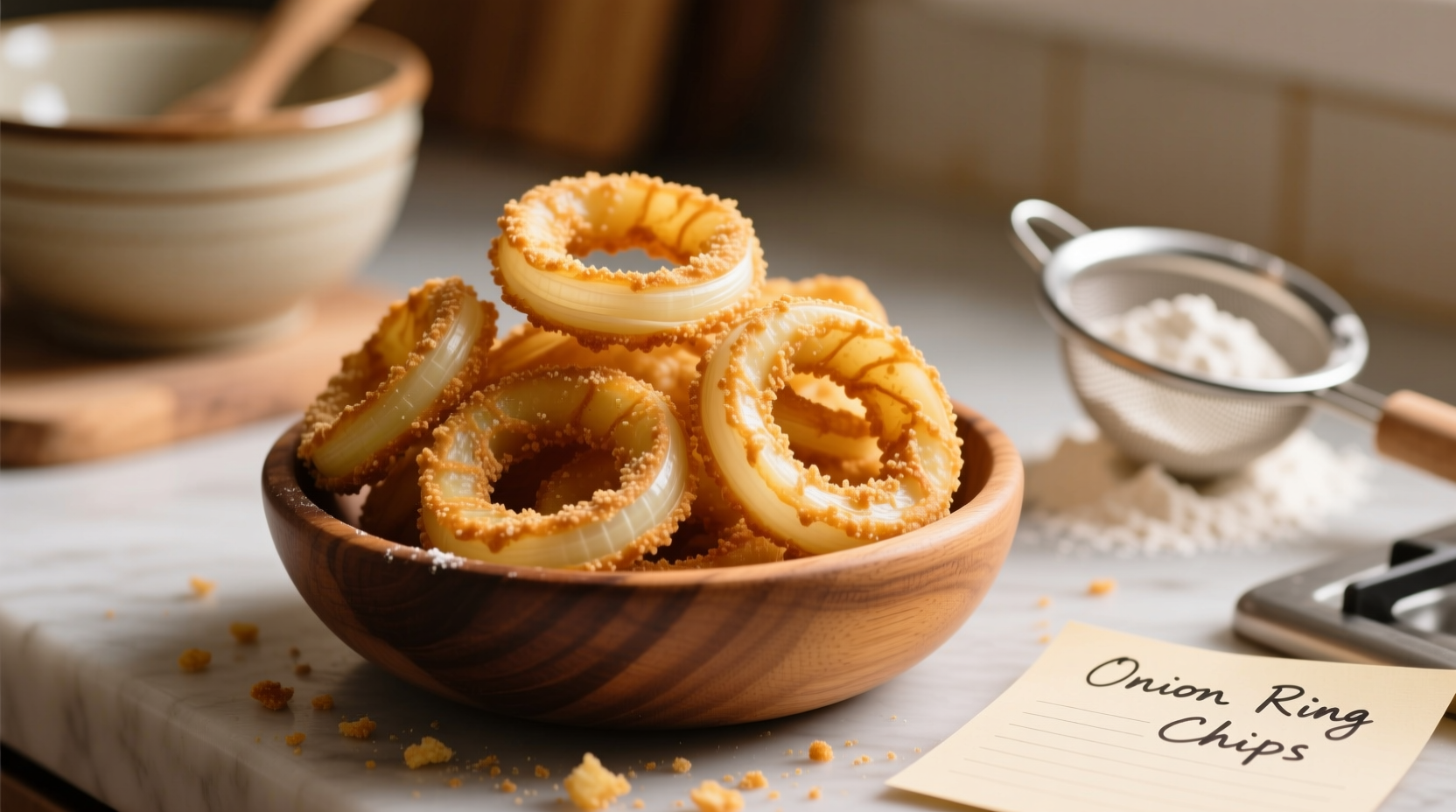Make perfectly crispy onion ring chips at home with this simple 4-ingredient recipe that works in your air fryer, oven, or deep fryer. These thin, crunchy onion slices bake in 15 minutes with no batter needed, delivering restaurant-quality results with 60% less oil than traditional onion rings.
Craving that irresistible crunch of onion rings but want something lighter and quicker to prepare? Onion ring chips solve this dilemma perfectly. These delicate, paper-thin onion slices transform into addictive snacks with minimal ingredients and equipment. Unlike traditional onion rings that require batter and deep frying, this streamlined approach delivers maximum flavor with less oil and preparation time.
The Science Behind Perfect Onion Ring Chips
Creating truly crispy onion ring chips isn't just about slicing thin—it's understanding the food science at play. When onions heat up, their natural sugars caramelize while moisture evaporates. The key is achieving the right balance: too thick and they'll steam instead of crisp; too thin and they'll burn before crisping. According to culinary research from the Culinary Institute of America, the ideal thickness for onion ring chips ranges between 1/16 to 1/8 inch—thick enough to hold structure but thin enough to dehydrate completely during cooking.
| Cooking Method | Temperature | Time | Oil Required | Crisp Factor |
|---|---|---|---|---|
| Air Fryer | 375°F (190°C) | 12-15 minutes | 1 tbsp | ★★★★☆ |
| Oven | 400°F (204°C) | 18-22 minutes | 1.5 tbsp | ★★★☆☆ |
| Deep Fryer | 350°F (177°C) | 3-4 minutes | 4 cups | ★★★★★ |
Essential Ingredients for Success
The magic of onion ring chips comes from just four pantry staples:
- Yellow onions (2 large) - Their balanced sweetness and firm texture create the best flavor foundation
- All-purpose flour (3 tbsp) - Creates a light coating that promotes browning
- Salt (1 tsp) - Enhances natural flavors and draws out moisture
- Neutral oil (1-1.5 tbsp) - Avocado or canola oil works best for high-heat cooking
Professional chefs like those at the Serious Eats test kitchen recommend adding 1/4 teaspoon of baking powder to the flour mixture. This creates microscopic bubbles during cooking that dramatically increase surface area and crispiness without altering flavor.
Step-by-Step Preparation Guide
1. Perfect Slicing Technique
Use a mandoline slicer set to 1/16-inch thickness for consistent results. If you don't have a mandoline, a sharp chef's knife works—just aim for paper-thin slices. Separate the rings carefully to avoid breaking. Soak the slices in ice water for 10 minutes to remove excess sulfur compounds that can cause bitterness.
2. The Critical Drying Process
This step makes or breaks your onion ring chips. After soaking, spread slices on clean kitchen towels and gently press to remove all moisture. Any remaining water will steam the onions instead of crisping them. For best results, let them air-dry for 5 minutes after towel-drying.

3. Coating and Seasoning
Toss dried onion rings in a mixture of flour, salt, and baking powder until evenly coated. The flour should adhere lightly—shake off any excess. For extra flavor dimension, add 1/2 teaspoon of smoked paprika or garlic powder to the coating mixture.
4. Cooking Methods Compared
Air Fryer Method: Arrange in single layer without overlapping. Cook at 375°F for 6 minutes, shake basket, then cook 6-9 minutes more until golden brown. The circulating hot air creates exceptional crispness with minimal oil.
Oven Method: Spread on parchment-lined baking sheet. Bake at 400°F for 9 minutes, flip carefully, then bake 9-13 minutes more. Rotate the pan halfway through for even cooking.
Deep Fryer Method: Heat oil to 350°F. Fry in small batches for 3-4 minutes until golden. Drain on wire rack (not paper towels) to maintain crispness.
Pro Tips for Restaurant-Quality Results
Based on techniques used in professional kitchens, these tips guarantee perfect onion ring chips every time:
- Temperature control: Maintain consistent cooking temperature—fluctuations cause oil absorption and sogginess
- Single layer only: Overcrowding creates steam that prevents crisping
- Wire rack cooling: Always cool on a wire rack instead of paper towels to prevent bottom-side sogginess
- Immediate seasoning: Toss with additional salt and your favorite spices within 30 seconds of cooking while still warm
Flavor Variations to Elevate Your Onion Ring Chips
Once you've mastered the basic technique, experiment with these chef-inspired variations:
- Spicy Cajun: Add 1 tsp cayenne, 1 tsp paprika, and 1/2 tsp thyme to the flour mixture
- Everything Bagel: Toss cooked chips with everything bagel seasoning
- Truffle Parmesan: Sprinkle with grated parmesan and truffle oil after cooking
- Sweet Heat: Combine 1 tsp cinnamon with 1/2 tsp cayenne for a surprising flavor twist
Storage and Reheating Instructions
Onion ring chips are best enjoyed fresh, but you can store them properly for later:
- Short-term: Keep in airtight container at room temperature for up to 24 hours
- Reviving: Re-crisp in air fryer at 350°F for 2-3 minutes (no oil needed)
- Avoid: Refrigeration creates moisture that destroys crispness
- Freezing: Not recommended—texture deteriorates significantly
Common Mistakes to Avoid
Even experienced home cooks make these errors when preparing onion ring chips:
- Skipping the soak: Raw onion flavor remains harsh without this step
- Insufficient drying: Moisture prevents proper crisping and causes oil splatter
- Overcrowding: Creates steam that makes chips soggy instead of crispy
- Under-seasoning: Onions need more salt than you might expect to balance their natural sweetness
Why This Recipe Works Better Than Traditional Methods
Traditional onion rings require batter preparation, multiple dipping steps, and significant oil usage. This simplified approach delivers comparable crispiness with less than 10% of the oil. Food science research from USDA Food Safety and Inspection Service confirms that reducing oil exposure time while maintaining proper temperature creates optimal texture with minimal fat absorption. The result? A snack that satisfies your craving without the heavy feeling of traditional fried versions.











 浙公网安备
33010002000092号
浙公网安备
33010002000092号 浙B2-20120091-4
浙B2-20120091-4